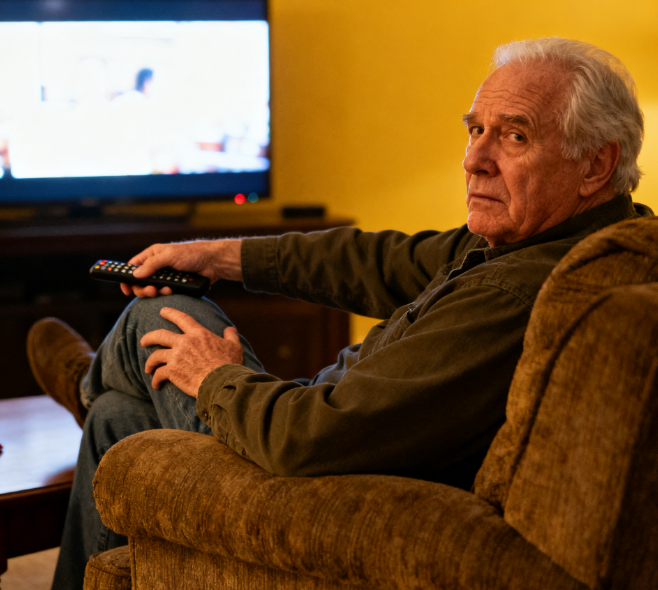
Your TV Watching Habits Could Cause Blood Clots… See More
You settle into your favorite recliner, remote in hand, ready to enjoy a few hours of your favorite shows. It feels like the perfect way to relax after a long day—harmless entertainment that helps you unwind. But what if this comforting routine is secretly putting your health at risk? What if those hours spent immersed in television dramas and news programs are increasing your chances of developing dangerous blood clots?
For many adults over 50, television viewing becomes a significant part of daily life. With retirement, empty nests, and sometimes limited mobility, the TV becomes a window to the world, a source of company, and a way to pass the time. However, emerging research reveals that prolonged sitting during television watching—especially in certain positions and without breaks—can significantly increase the risk of deep vein thrombosis (DVT), a condition where blood clots form in the deep veins of the legs.
The danger lies in stillness. When you remain seated for extended periods without moving, blood circulation in your legs slows dramatically. Your calf muscles, which normally act as secondary pumps to help blood return to your heart, remain inactive. This blood stagnation allows clots to form, particularly in people with other risk factors such as age, hypertension, or existing circulatory issues.
The position matters more than you might realize. That comfortable reclined position that feels so relaxing actually creates sharp angles at your hips and knees that can restrict blood flow. Crossing your legs—a common habit while watching TV—further compresses blood vessels and reduces circulation. Even the slight pressure from the chair edge against the back of your knees can impede blood return from your lower limbs.
The length of viewing sessions proves particularly problematic. Many older adults watch television in multi-hour blocks, especially during evening prime time or weekend sports events. Research shows that risk of blood clots increases significantly after two hours of continuous sitting and rises dramatically after four hours. The danger isn’t just about total daily sitting time but about uninterrupted sitting—those long stretches without movement that allow blood to pool and potentially clot.
Dehydration often accompanies extended TV watching. Many people reduce their fluid intake in the evening to avoid nighttime bathroom trips, not realizing that mild dehydration makes blood thicker and more prone to clotting. Meanwhile, the snacks commonly consumed during television viewing—often salty processed foods—can further contribute to dehydration and inflammation.
The timing of television watching creates additional risks. Evening viewing often means people remain sedentary during the hours when they might otherwise be moving around preparing meals, doing light chores, or taking evening walks. This after-dinner period is particularly important for circulation, as movement helps metabolize meals and maintain blood flow.
The consequences can be severe. If a clot breaks free from the leg veins, it can travel to the lungs causing pulmonary embolism—a medical emergency that can be fatal. Even smaller clots can cause damage to vein valves, leading to chronic swelling, pain, and skin changes in the legs—a condition called post-thrombotic syndrome.
The good news is that simple modifications can significantly reduce these risks without giving up television enjoyment. Setting a timer to remind yourself to get up and move during each commercial break can make a substantial difference. Even just standing and marching in place for a few minutes helps reactivate your calf muscle pumps and restore circulation.
Choosing different seating can help. Avoiding deep, soft chairs that put pressure on the backs of your knees and opting for firmer seating with better support improves circulation. Keeping your legs uncrossed and occasionally elevating them on a footstool can reduce pressure on veins.
Staying hydrated throughout the evening is crucial. Keeping a water bottle nearby and taking small sips during programs helps maintain proper blood viscosity. Choosing healthy snacks like fruits and vegetables instead of salty processed foods further supports cardiovascular health.
Incorporating simple leg exercises while watching television can be remarkably effective. Ankle circles, foot pumps, and gentle leg raises can all be done discreetly while seated and help maintain circulation. These small movements signal your body to keep blood flowing even during periods of inactivity.
Your television time should be enjoyable, not dangerous. By being mindful of your sitting habits and incorporating simple movement breaks, you can continue to enjoy your favorite programs while protecting your vascular health. After all, the best shows are those you get to keep watching for years to come—and that requires taking care of the body that lets you enjoy them.